

Japan’s Premium Denim
|
Usually when you hear “denim jeans”, you would think of the U.S. where it first gained popularity in the 1870s. However, did you know that there is a town in Japan associated with denim jeans? Kojima district of Kurashiki city in Okayama Prefecture is widely known as the birthplace of Japanese denim.
That being said, Kojima did not start out as a denim hub. In the past, Okayama was very much rooted in the textile industry, specifically the cotton industry. While there was a push for rice cultivation in the 18th Century, the low rainfall in Okayama did not encourage rice cultivation. Additionally, reclaimed land from the sea, including Kojima, were too salty to grow rice. Due to this, the focus switched to cotton, with cotton production and indigo dyeing taking off in the 1600s. Okayama soon became a centre for manufacturing school uniforms. This included Kojima, delving in the production of thick cloth for bags and school uniforms, alongside the development of techniques and equipment for sewing thick cloth. Unfortunately, business started to drop as demand for synthetic fibres picked up in the early 20th Century. Coincidentally in the 1960s, second-hand jeans were imported from the U.S. and this quickly garnered the interest of Japanese youths. Considering the heightened interest in denim jeans, as well as the experience and expertise in dyeing, weaving, sewing and processing, it only seemed natural for Kojima to transition to manufacturing denim jeans. The first denim jeans made in Japan was in Kojima in 1965. Inspired by the American roots, the company chose the brand names “Big John” and “Betty Smith” for its men and women labels respectively. The company first used denim fabric and sewing machines from the U.S., but moved to create its own denim using shuttle looms and traditional indigo dyeing techniques. Thus, Japanese denim jeans came about. Since then, Kojima has flourished into a “Mecca of Jeans”, earning a reputation in Japan and across the world. Some overseas luxury brands use the denim fabric from Kojima, including Gucci, Dior and Chanel. One particular Kojima jeans label, Momotaro Jeans, has a one-year waiting list for its made-to-measure jeans. Kojima jeans is synonymous with premium quality, whether it concerns the raw material or the meticulous processing. For example, Momotaro Jeans goes through 15 different types of machines and over 30 sewing processes when manufacturing a pair of jeans. Kojima jeans does not only get softer when it is washed, it also becomes more comfortable to wear and may even change colour over time. This is because the denim fabric is dyed with such a distinctive indigo blue colour that it is labelled “Japan blue”, and its solid colour can slowly fade over time to reveal different colours or colour gradations. At Kojima, you can find a wide range of denim products in over 30 stores lined up at Jeans Street. Aside from jeans, stores have branched out to offer denim jackets, skirts, bags, wallets and more. True to its name, the road of Jeans Street is dyed indigo and the red and white painted lines at the side resemble the denim’s selvage. The vending machines, buses and taxis are even covered from head to toe in denim pattern. Besides stores specialising in denim, there are also galleries, restaurants and cafes, and you can even try blue soft-serve ice-cream! The next time you visit Japan, why not consider dropping by Kojima’s Jeans Street to get a pair of unique jeans made just for you? |
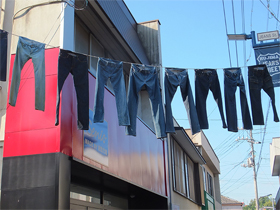 © The Kojima Chamber of Commerce and Industry 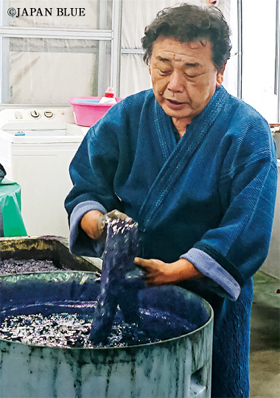 © JAPAN BLUE Co., Ltd. 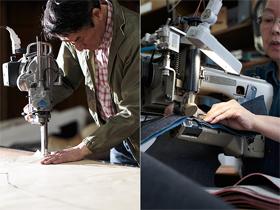 © Japan Blue Co., Ltd. (Momotaro Jeans) 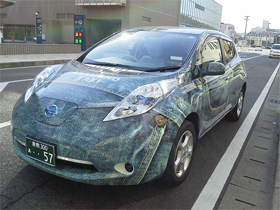 © Akebono Taxi 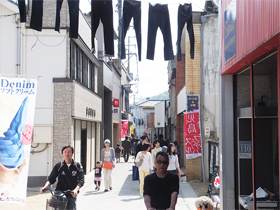 © The Kojima Chamber of Commerce and Industry |
Resources
|
“Finding the Perfect Match, Fans Rave about Kojima Jeans!”. 2017. Web Japan. https://web-japan.org/trends/11_fashion/fas170406.html. “Exploring Jeans Street in Kojima, a District Dyed in Indigo”. 2020. Japan National Tourism Organization. Accessed 15 August. https://www.japan.travel/en/japan-magazine/exploring-jeans-street-in-kojima-city-dyed-in-indigo/. Alimin, Jasmine. 2021. “The Japanese denim label with a one-year waiting list for its S$2,600 jeans”. CNA Luxury. https://cnaluxury.channelnewsasia.com/remarkableliving/momotaro-jeans-cult-japanese-denim-184691. Choat, Isabel. 2019. “Jean genius: how Kojima became Japan’s denim mecca”. The Guardian. https://www.theguardian.com/travel/2019/sep/24/jean-genius-how-kojima-became-japans-denim-mecca. Lawson, Louise. 2019. “Okayama: The land of sunshine and great denim”. Japan Today. https://japantoday.com/category/special-promotion/okayama-sunshine-and-denim. Chordas, Peter Michael. 2022. “Kojima Jeans Street – Weaving History from the World’s Finest Denim”. Setouchi Reflection Trip. Accessed 15 August. https://setouchitrip.com/art-culture/1375. |
|
Japan Creative Centre 4 Nassim Road, Singapore 258372 +65 6737 0434 / jcc@sn.mofa.go.jp https://www.sg.emb-japan.go.jp/JCC/ Nearest parking at Orchard Hotel & Delphi Orchard |
 |